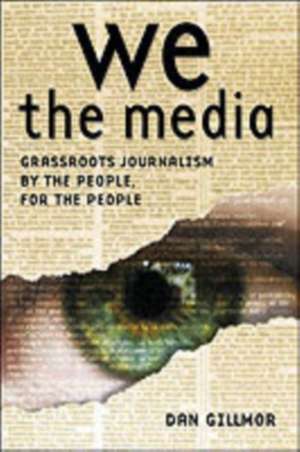We the Media: OREILLY
Autor Dan Gillmoren Limba Engleză Paperback – 9 feb 2006
Big Media has lost its monopoly on the news, thanks to the Internet. Now that it's possible to publish in real time to a worldwide audience, a new breed of grassroots journalists are taking the news into their own hands. Armed with laptops, cell phones, and digital cameras, these readers-turned-reporters are transforming the news from a lecture into a conversation. In We the Media, nationally acclaimed newspaper columnist and blogger Dan Gillmor tells the story of this emerging phenomenon and sheds light on this deep shift in how we make--and consume--the news.
Gillmor shows how anyone can produce the news, using personal blogs, Internet chat groups, email, and a host of other tools. He sends a wake-up call tonewsmakers-politicians, business executives, celebrities-and the marketers and PR flacks who promote them. He explains how to successfully play by the rules of this new era and shift from "control" to "engagement." And he makes a strong case to his fell journalists that, in the face of a plethora of Internet-fueled news vehicles, they must change or become irrelevant.
Journalism in the 21st century will be fundamentally different from the Big Media oligarchy that prevails today. We the Media casts light on the future of journalism, and invites us all to be part of it.
Dan Gillmor is founder of Grassroots Media Inc., a project aimed at enabling grassroots journalism and expanding its reach. The company's first launch is Bayosphere.com, a site "of, by, and for the San Francisco Bay Area."
Dan Gillmor is the founder of the Center for Citizen Media, a project to enable and expand reach of grassroots media. From 1994-2004, Gillmor was a columnist at the San Jose Mercury News, Silicon Valley's daily newspaper, and wrote a weblog for SiliconValley.com. He joined the Mercury News after six years with the Detroit Free Press. Before that, he was with the Kansas City Times and several newspapers in Vermont. He has won or shared in several regional and national journalism awards. Before becoming a journalist he played music professionally for seven years.
Din seria OREILLY
-
 Preț: 150.35 lei
Preț: 150.35 lei - 20%
 Preț: 190.49 lei
Preț: 190.49 lei - 20%
 Preț: 265.42 lei
Preț: 265.42 lei - 20%
 Preț: 271.55 lei
Preț: 271.55 lei - 20%
 Preț: 254.53 lei
Preț: 254.53 lei - 20%
 Preț: 277.81 lei
Preț: 277.81 lei - 20%
 Preț: 206.58 lei
Preț: 206.58 lei -
 Preț: 170.72 lei
Preț: 170.72 lei - 20%
 Preț: 106.37 lei
Preț: 106.37 lei - 20%
 Preț: 224.93 lei
Preț: 224.93 lei - 20%
 Preț: 326.28 lei
Preț: 326.28 lei - 20%
 Preț: 173.65 lei
Preț: 173.65 lei - 20%
 Preț: 130.89 lei
Preț: 130.89 lei - 20%
 Preț: 234.63 lei
Preț: 234.63 lei - 20%
 Preț: 158.05 lei
Preț: 158.05 lei - 20%
 Preț: 135.48 lei
Preț: 135.48 lei - 20%
 Preț: 135.48 lei
Preț: 135.48 lei - 20%
 Preț: 177.23 lei
Preț: 177.23 lei - 20%
 Preț: 321.10 lei
Preț: 321.10 lei - 20%
 Preț: 279.05 lei
Preț: 279.05 lei - 20%
 Preț: 116.13 lei
Preț: 116.13 lei - 20%
 Preț: 136.72 lei
Preț: 136.72 lei - 20%
 Preț: 215.92 lei
Preț: 215.92 lei - 20%
 Preț: 168.25 lei
Preț: 168.25 lei - 20%
 Preț: 210.68 lei
Preț: 210.68 lei - 20%
 Preț: 229.55 lei
Preț: 229.55 lei - 20%
 Preț: 232.96 lei
Preț: 232.96 lei - 20%
 Preț: 180.40 lei
Preț: 180.40 lei - 20%
 Preț: 189.18 lei
Preț: 189.18 lei - 20%
 Preț: 187.89 lei
Preț: 187.89 lei - 20%
 Preț: 233.75 lei
Preț: 233.75 lei - 20%
 Preț: 273.96 lei
Preț: 273.96 lei - 20%
 Preț: 191.60 lei
Preț: 191.60 lei -
 Preț: 243.02 lei
Preț: 243.02 lei - 20%
 Preț: 226.86 lei
Preț: 226.86 lei - 20%
 Preț: 217.25 lei
Preț: 217.25 lei - 20%
 Preț: 243.52 lei
Preț: 243.52 lei -
 Preț: 152.95 lei
Preț: 152.95 lei - 20%
 Preț: 217.14 lei
Preț: 217.14 lei - 20%
 Preț: 284.64 lei
Preț: 284.64 lei - 20%
 Preț: 241.98 lei
Preț: 241.98 lei - 20%
 Preț: 207.51 lei
Preț: 207.51 lei - 20%
 Preț: 167.14 lei
Preț: 167.14 lei - 20%
 Preț: 173.86 lei
Preț: 173.86 lei - 20%
 Preț: 250.59 lei
Preț: 250.59 lei - 20%
 Preț: 280.32 lei
Preț: 280.32 lei - 20%
 Preț: 202.64 lei
Preț: 202.64 lei - 20%
 Preț: 297.17 lei
Preț: 297.17 lei - 20%
 Preț: 159.30 lei
Preț: 159.30 lei
Preț: 86.03 lei
Preț vechi: 107.53 lei
-20% Nou
Puncte Express: 129
Preț estimativ în valută:
16.46€ • 17.19$ • 13.62£
16.46€ • 17.19$ • 13.62£
Carte disponibilă
Livrare economică 15-29 martie
Preluare comenzi: 021 569.72.76
Specificații
Notă biografică
Dan Gillmor is founder of Grassroots Media Inc., a project aimed at enabling grassroots journalism and expanding its reach. The company's first launch is Bayosphere.com, a site "of, by and for the Bay Area." Gillmor is is author of We the Media: Grassroots Journalism by the People, for the People (O'Reilly Media, 2004), a book that explains the rise of citizens' media and why it matters.From 1994-2004, Gillmor was a columnist at the San Jose Mercury News, Silicon Valley's daily newspaper, and wrote a weblog for SiliconValley.com. He joined the Mercury News after six years with the Detroit Free Press. Before that, he was with the Kansas City Times and several newspapers in Vermont. A Phi Beta Kappa graduate of the University of Vermont, Gillmorreceived a Herbert Davenport fellowship in 1982 for economics and business reporting at the University of Missouri School of Journalism. During the 1986-87 academic year he was a journalism fellow at the University of Michigan in Ann Arbor, where he studied history, political theory and economics. He has won or shared in several regional and national journalismawards. Before becoming a journalist he played music professionally for seven years.
Cuprins
Epigraph; Introduction; Endnotes; Chapter 1: From Tom Paine to Blogs and Beyond; 1.1 The Corporate Era; 1.2 From Outside In; 1.3 Ransom-Note Media; 1.4 Out Loud and Outrageous; 1.5 The Web Era Emergent; 1.6 Writing the Web; 1.7 Open Sourcing the News; 1.8 Terror Turns Journalism's Corner; 1.9 Endnotes; Chapter 2: The Read-Write Web; 2.1 Mail Lists and Forums; 2.2 Weblogs; 2.3 Wiki; 2.4 SMS; 2.5 Mobile-Connected Cameras; 2.6 Internet "Broadcasting"; 2.7 Peer-to-Peer; 2.8 The RSS Revolution; 2.9 Making Sense of It All; 2.10 Endnotes; Chapter 3: The Gates Come Down; 3.1 Spreading the Word; 3.2 Truth Squad; 3.3 Looking Deeper; 3.4 Bubble, Bubble, Tout and Trouble; 3.5 Swarming Investigators and Spies; 3.6 Watching Journalists; 3.7 Turning the Tables; 3.8 Endnotes; Chapter 4: Newsmakers Turn the Tables; 4.1 Learning by Listening; 4.2 Blog It; 4.3 The Celebrity Blog; 4.4 Talking to the Audience; 4.5 Fine-Grain Pitching; 4.6 Some Rules for New-World PR and Marketing; 4.7 Endnotes; Chapter 5: The Consent of the Governed; 5.1 Business as Usual; 5.2 What's New Is Old; 5.3 Electing a President; 5.4 Dean Meets Meetup, Blogs, and Money; 5.5 Cash Cow, and Catching Up; 5.6 Open Source Politics; 5.7 A Changing Role for Journalists; 5.8 The Tools of Better Governance; 5.9 Endnotes; Chapter 6: Professional Journalists Join the Conversation; 6.1 Traditional Media's Opportunity; 6.2 Authority from Linking, Listening; 6.3 Asking the Former Audience for Help; 6.4 Case Study: Promoting, Then Reporting, Activism; 6.5 Case Study: The Citizen Reporters; 6.6 Newsroom Tools; 6.7 Teaching New Tricks; 6.8 A Question of Trust; 6.9 Endnotes; Chapter 7: The Former Audience Joins the Party; 7.1 Citizen Journalist: Bloggers (and More) Everywhere; 7.2 Evolutionary and Revolutionary; 7.3 Nonprofit Community Publishing; 7.4 Alternative Media Flourishes; 7.5 The Wiki Media Phenomenon; 7.6 Business Models for Tomorrow's Personal Journalism; 7.7 New Business Models: The Tip Jar; 7.8 Endnotes; Chapter 8: Next Steps; 8.1 Laws and Other Codes; 8.2 Creating the News; 8.3 Sorting It Out; 8.4 Syndication Takes Off; 8.5 The World Live Web; 8.6 Probing APIs and Web Services; 8.7 Okay, but Whose "Information" Do You Trust?; 8.8 Dinosaurs and Dangers; 8.9 Endnotes; Chapter 9: Trolls, Spin, and the Boundaries of Trust; 9.1 Cut and Paste, Right and Wrong; 9.2 New Ways to Mislead; 9.3 Who's Talking, and Why?; 9.4 Trolls and Other Annoyances; 9.5 Spin Patrol; 9.6 Citizen Reporters to the Rescue; 9.7 A Flight to Quality?; 9.8 Plain Old Common Sense; 9.9 Endnotes; Chapter 10: Here Come the Judges (and Lawyers); 10.1 Defamation, Libel, and Other Nasty Stuff; 10.2 Jurisdiction; 10.3 Email and Free Speech; 10.4 Misusing Other People's Work; 10.5 Copyrights and Wrongs; 10.6 Forbidden Links and Other Outrages; 10.7 Endnotes; Chapter 11: The Empires Strike Back; 11.1 Governments Get Nervous; Big Business Gets Nosy; 11.2 The Copyright Cartel; 11.3 Eye of the Beholder; 11.4 Charm and Toughness; 11.5 The Tech Industry Sellout; 11.6 The End of End-to-End?; 11.7 Return of the Jedi Users; 11.8 A Deregulatory Rescue?; 11.9 The End of Scarcity?; 11.10 Endnotes; Chapter 12: Making Our Own News; 12.1 A Creative Commons; 12.2 Day-to-Day Changes; 12.3 Endnotes; Epilogue and Acknowledgments; Outline and Ideas; Drafts and Other Postings; Acknowledgments; Endnotes; Web Site Directory; Glossary; Colophon;
Descriere
Shows how anyone can produce the news, using personal blogs, Internet chat groups, email, and a host of other tools. This book tells the story of this emerging phenomenon and sheds light on this deep shift in how we make - and consume - the news.














